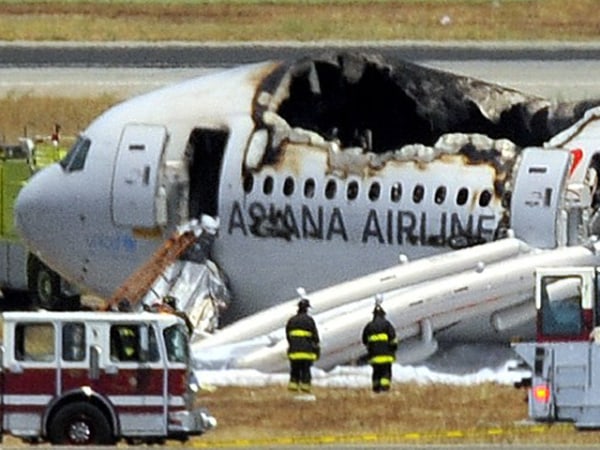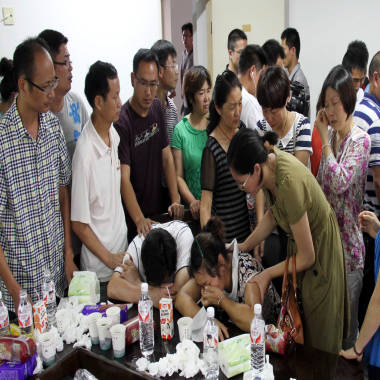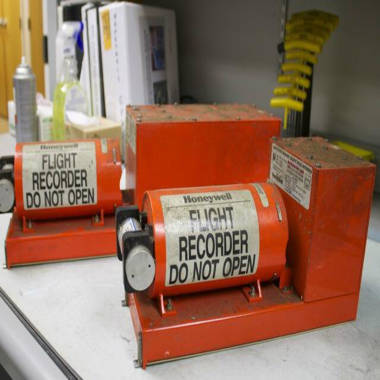
Josh Edelson / AFP - Getty Images
A Boeing 777 operated by Asiana Airlines crash landed at SFO.
By Julie Yoon, F. Brinley Bruton and Matthew DeLuca, NBC News
A cockpit voice recorder recovered from Asiana Airlines Flight 214 revealed the pilots attempted to abort the landing just 1.5 seconds before the jet crashed in San Francisco, killing two and injuring scores, federal investigators said Sunday.?
National Transportation Safety Board chief Deborah Hersman said at a Sunday news conference that the ?black box? flight data recorders also showed there was an attempt to boost airspeed just before the aircraft impacted the sea wall and then slammed into the runway.
There was no evidence in the two recovered ?black boxes? that the Boeing 777 was experiencing any problems before the crash on Saturday, Hersman said. The airline?s president said earlier that engine failure was likely not the cause of the deadly incident.?
The ?black boxes? from the aircraft, which record critical in-flight data, were recovered from the wreckage and transported on a late-night flight to Washington, D.C., then by guard to the NTSB lab for examination, Hersman said. NTSB investigators were analyzing both the cockpit voice recorder and flight data recorder for clues as to what went wrong. Herman said the information detailed at the news conference was preliminary.
The black boxes from the relatively new plane could potentially contain thousands of data points about the plane's behavior before the crash. Hersman said investigators are also planning to conduct interviews with the pilots, the crew and passengers in order to reconstruct the events leading up to the dramatic event.
Asiana Airlines told NBC News that Lee Kang-kook, the pilot in charge of landing the plane, was in "transition training" to qualify to fly the Boeing 777, and it was his first attempt to fly into San Francisco while manning a 777. The airline said Kang-kook had flown different planes to that airport and was also being assisted by a more experienced pilot.
The flight to San Francisco was Kang-kook's ninth flying a 777 for a total of 43 hours, the airline said, and he has flown 9,700 hours in an Airbus A320. To qualify as a captain on the 777 requires 60 hours of flight time and 10 takeoffs and landings, the airline said.
The two passengers who died in the crash were identified as Chinese girls in their teens, airline president Yoon Young-doo said at a press conference in Seoul, South Korea, on Sunday. The official Weibo microblog account for Asiana identified the victims as Ye Mengtuan and Wang Linjia, both 16 years old. The two were students at Jiangshan Middle School, according to the airline.
?We think there was no engine defect,? Yoon said.

AP
Parents of Wang Linjia, center, are comforted by parents of some other students who were on the Asiana Airlines Flight 214 when it crashed at San Francisco International Airport, while they gather and wait for news of their children at Jiangshan Middle School in Jiangshan city, in eastern China's Zhejiang province, Sunday July 7, 2013.
A team of NTSB investigators had its first full day on the ground Sunday, collecting and sifting through evidence at the site of the crash that ?could have been much worse,? Hersman told Meet the Press.
A photograph published on the NTSB?s official Twitter account showed Hersman and Bill English, the investigator-in-charge, looking at the charred interior of the aircraft where collapsed luggage containers and other equipment hung from the ceiling.
?We have a lot of information to go through, and I think at this point everything is still on the table for us,? Hersman said. ?We have to not only identify what we?re focused on, but also to rule things out, and to do that we need good evidence.?
While the NTSB was working in conjunction with the FBI, Hersman said that there was still ?no indication? that any criminal activity was involved in the crash.
More than 180 people were transported to area hospitals after the crash landing that left debris strewn across the runway and ripped open the plane?s tail.
Of the 291 passengers and 16 crew members on board at the time of the crash, 49 incurred serious injuries including fractures and burns and were taken to one of nine Bay Area hospitals. The injured ranged in age from 20 to 76 years old.
Dr. Margaret Knudson, chief of surgery at San Francisco General, said on Sunday that her doctors and nurses had seen a large number of abdominal and spinal injuries, with many of the patients they spoke to telling them that they had been in the back of the plane during the crash. She said that six patients remained in critical condition at the hospital, including two with ?road rash? injuries across their bodies consistent with what might be seen after a motorcycle accident.
Triage teams at the airport may have saved lives, Knudson said, adding that without the immediate care the patients received, ?I can tell you two of them likely would not have survived.?
?We are very sorry for the pain to the families and passengers,? Asiana chief executive Yoon said on Sunday.

NTSB
Asiana flight data recorder, left, and cockpit voice recorder, right, in NTSB's Washington lab.
Passenger Benjamin Levy said he heard screams after the crash landing, and for a few moments, confusion filled the cabin.
"It was surreal," Levy told NBC Bay Area on Saturday, shortly after being taken by ambulance from San Francisco International Airport. ?"A lot of people screaming and not really believing what has happening to them. I wasn?t believing it either."
Get more local coverage of crash on NBC Bay Area
Among those who made it to safety were 34 Chinese high school students and a teacher, on their way to summer camp near Los Angeles, according to NBC Los Angeles.
The group was slated to arrive at West Valley Christian School in West Hills, an upscale city in Los Angeles County, for a three week stay, NBC Los Angeles reported. The school said via its website that it planned to hold a campus prayer vigil at 10 p.m. ET Sunday.
The crash ? the first involving a jumbo jet in the United States in more than a decade ? happened at 11:27 a.m. local time. It left a field of debris down the runway, beginning at the seawall that divides the runway from San Francisco Bay. Pieces of the tail could be seen among the wreckage.
As the plane approached the runway from the waters of San Francisco Bay, travelers in the terminals and others eyewitnesses could see that the aircraft was swaying unusually from side to side and that at one point the tail seemed to hit the ground before breaking off.
Tom Costello and Chairman of the NTSB, Debbie Hersman discuss the latest developments on the crash landing in San Francisco.
Despite the deaths and scores of injuries -- many of them serious -- San Francisco Mayor Edwin Lee said at a Saturday evening news conference that "This could have been much worse."
Federal investigators said on Saturday that it was too early to determine a cause. Hersman said at the afternoon news conference that it may take months before investigators have a hypothesis.
Sources who spoke with NBC News said the pilot did not make a distress call before landing. The plane crashed in favorable weather ? partly cloudy skies and light wind.
A San Francisco airport spokesman said that a component of the facility's instrument landing system that tracks an incoming airplane's glide path was not working on Saturday.
Hersman confirmed Sunday that the so-called Glide Path system ? a ground-based aid that helps guide pilots to a safe descent ? had been shut down at SFO since June.
But pilots and air safety experts said the technology was far from essential for a safe landing in good weather.
Kevin Hiatt, chief executive of the Flight Safety Foundation and a former Delta pilot, said it was common for airports to take instrument landing systems offline for maintenance on clear days. Pilots use several other instruments and visual cues to land in clear conditions, Hiatt said.
The fiery crash landing of a Korean jetliner at the San Francisco International Airport late Saturday morning has left at least two people dead, and up to 70 injured, according to NBC Bay Area station KNTV. Hospitals say some of the injured are critical. NBC's Lester Holt reports.
"All of those are more than adequate to fly an aircraft down for a successful landing on the runway," he said.
Stefanie Turner, a witness, told MSNBC that she saw the plane clip the runway with its tail, then come to rest with flames and smoke billowing from the fuselage.
?The tail was too low. Instead of coming in flat it was coming in at, I would say, maybe a 45-degree angle, with the tail far too low,? she said.
?It really went through quite a few acrobatics on the runway.?
The jet carried 141 Chinese, 77 Koreans, 61 Americans, three passengers from India, one each from Japan and Vietnam and seven whose nationalities were unknown, the airline said. A situation room was set up in Beijing to provide information and help to the families of Chinese passengers, Yoon said.
Three of the four runways at SFO were open Sunday afternoon, the airport announced.
NBC News'?Erin McClam, Emma Ong, Daniel Arkin,?Julie Yoo, Le Li, Jay Blackman, Jonathan Dienst, Richard Esposito, Tracy Jarrett and Kristen Welker contributed to this report. The Associated Press and Reuters also contributed.
San Francisco Mayor Edwin Lee thanks the first responders of the Asiana Airlines crash and says "this could have been much worse."
Related:
?
This story was originally published on Sun Jul 7, 2013 1:59 PM EDT
merry Christmas a christmas story twas the night before christmas santa Capital STEEZ George Bush After Christmas Sales 2012
No comments:
Post a Comment